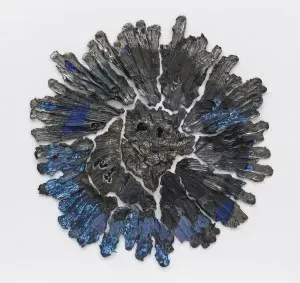Тадааки Куваяма (1932–2023)

Японский минималист Тадааки Куваяма, известный своими металлическими монохромными работами, которые одновременно вызывают помехи промышленности и длительную спокойствие вечности, скончался. Куваяма было девяносто один год. Новость о его смерти была объявлена Алисон Брэдли Проектс, которая представляет художника. Как и многие японцы своего поколения, Куваяма переехал в США в конце 1950-х годов.
Прибыв в сумерках абстрактного экспрессионизма и на заре поп- и минимализма, среди друзей и современников, включая Дэна Флавина, Сэма Фрэнсиса, Дональда Джадда, Кензо Окада и Франка Стеллу, он быстро завоевал себе репутацию своим творчеством, которое, как написал Ронни Коэн в 1989 году в выпуске Artforum, "привлекает внимание к вопросам конструкции, к повторению действий, что приводит к формам, нагруженным тайной". Тадааки Куваяма родился в промышленном городе Нагоя, Япония, в 1932 году. После окончания Токийского национального университета искусств, где он изучал нихонгу, или традиционную японскую живопись, Куваяма в 1958 году переехал в Нью-Йорк со своей женой, художницей Ракуко Найто. Сначала он поступил в Школу художников, но, как он рассказал Косуке Фуджитаке из New York Art Beat в 2012 году, "это было не очень интересное место; туда ходили любители и буржуазные жены, а преподаватели были консерваторами.
Поэтому я почти не ходил в школу. Я только подписался и пошел домой." Куваяма вместо этого был активно вовлечен в художественную сцену города и начал ряд исследований, которые привели к открытию его собственного уникального стиля. Это наиболее известно через монохромное полотно, разделенное узкими, иногда пересекающимися металлическими полосами. В его "Безымянном: Красном и Синем" 1961 года, который он показал в том же году в Грин Галерее Ричарда Беллами в Нью-Йорке, он обернул прямоугольное полотно определенным типом текстиля.Бумага, обычно используемая в нихонге, которую он отчаянно пытался избежать, была типична для его работ.
Перешедший от верхней красной половины до нижней синей половины его работы и тонкий полосатый полос из металлического серебряного листа. "Раньше я никогда не использовал масляные краски, поэтому я не знал, какие техники здесь используются", - объяснил он Фуджитаке. "И всё же я не мог выносить этого типа живописи, который я уже знал". В следующем году Куяма начал исследование трехмерности, создав свою первую самостоятельную половину работы из панели размером 4х8 футов, украшенной японской бумагой и покрытой черным красителем.
К 1965 году он в основном отказался от бумаги и перешел на краску в аэрозольной упаковке, что позволило ему создавать ровные поверхности без следов от кисти и без признаков их создания. К этому моменту большинство его работ были квадратными, а серебряный лист был заменен полосами из алюминия или хрома, которые могли разделить работу на квадранты или прямоугольные и треугольные половины. В своих частых ярких оттенках и глянцевых лакированных поверхностях работы ссылались на материалы, распространенные в автомобильной и аэрокосмической промышленности, которые доминировали в его родном городе. В то же время их однотонные цвета, измеряемые сегменты и повторяющиеся формы пробуждали ощущение спокойствия.
"Куяма... умудряется извлечь из своих ограниченных средств удивительно личное заявление", написала Барбара Роуз в номере Artforum 1967 года. Куяма в последующие десятилетия расширил свою практику, включив субстраты, такие как бакелит, майлар и титан, которые добавили твердости и блеска его работам, но не ослабили их неопределенную теплоту. Художник продолжал фокусироваться на чистом оттенке и форме, исключая все другие вопросы, включая тот, связанный с воспринимаемой иерархией цвета, которая могла бы определить порядок представления данного набора работ.
"Я думаю, что цвета должны представляться равноправными", - пояснил он. "Суть в том, что они просто существуют". Работы Куямы находятся в коллекциях крупных международных учреждений.Включая Музей современного искусства в Сан-Франциско; Музей искусства Индианаполиса; Картинную галерею Альбрайт-Нокс в Буффало; Музей современного искусства и Музей Соломона Р. Гуггенгайма, оба в Нью-Йорке; Фонд "Штифтунг фюр Конструктиве унд Конкрете Кунст" в Цюрихе; Национальная галерея в Берлине; Штатсгалерея в Штутгарте; Музей города Хиросима; Национальный музей искусства в Осаке; Музей современного искусства 21-го века в Канадзаве; Городской художественный музей Нагои; Музей современного искусства Хара, Музей современного искусства и Национальный музей современного искусства, все в Токио; и Мемориальный музей искусства Кавамура в Чибе.
Ощущение спокойствия и вечности в его творчестве проистекало из его убеждения, что его работа должна представлять собой ощущение существования. "Люди не просто живут в настоящем; они живут в сознании того, что впереди будущее", - сказал он Фуджитаке. "Я думаю, искусство должно быть таким же"..